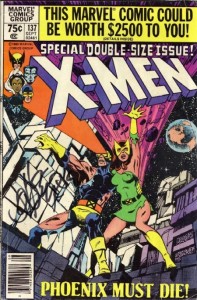Think back for a minute to say, high school or college. A pretty sizable chunk of your life, right?
Now imagine spending four times that long writing a single group of characters.
Sixteen years. That’s how long Chris Claremont was the writer on Marvel’s UNCANNY X-MEN, the series he revitalized, which in turn revitalized the American comic-book market with its breakthrough success, as well as supplanting Spider-Man as Marvel Comics’ trademark series and primary cash cow.
Claremont got his first break at Marvel writing IRON FIST, the company’s kung-fu hero, before being assigned X-MEN just as the series was returning to print in 1975 after a long layoff. Although the new team and its superheroic mutant characters had been earlier created by Len Wein in their debut appearance in GIANT-SIZE X-MEN #1, their personalities and relationships were the sole creation of Claremont, who took over the series with issue #94, the first to follow their GIANT-SIZE return.
In Claremont’s hands UNCANNY X-MEN was like nothing else Marvel was publishing at the time. Claremont was clearly plotting for the long haul, with lengthy, continued storylines that would last for months at a time, and subplots that could linger on for years (some would say to the series’ detriment, but we’d argue that his hit-miss ratio on the subplots eventually paying off leans far in Claremont’s favor). In Claremont’s hands, the book was a true ensemble, with all of the team members getting their fair share of the spotlight (with the possible exception of Professor Xavier, who Claremont had a tendency to remove from the picture so as not to let his perhaps-too-powerful psychic abilities solve things too easily and too often). Another trademark of Claremont’s run would be strong female protagonists, from Jean Grey, Storm and Moira MacTaggart in the series’ early years to later additions like Rogue and Kitty Pryde.
From a narrative perspective, Claremont made great use of third-person narration, almost to the point of intrusion, yet his facility as a writer was such that the reader didn’t mind, instead being drawn in by his elegant turn of phrase. And in terms of theme, Claremont found the exact right tone to make X-MEN constantly relevant to young readers, keying in on the feelings of alienation and awkwardness familiar to every adolescent, to allow them to identify so strongly with the characters, while at the
Claremont’s best work is probably his most famous one, “The Dark Phoenix Saga” from the pages of UNCANNY X-MEN, which traumatized a generation of young readers with the unexpected death of the series’ lead heroine Jean Grey. However, to really appreciate the scope of what Claremont accomplished, you have to look at his 16-year X-MEN run as a whole, an over-4,000-page literary work that continues to influence popular culture to this day, both in the comics still being created that bear its influence, to the hundreds of television shows and numerous movies about the X-Men that continue to mine Claremont’s work for material.


Comments are closed.